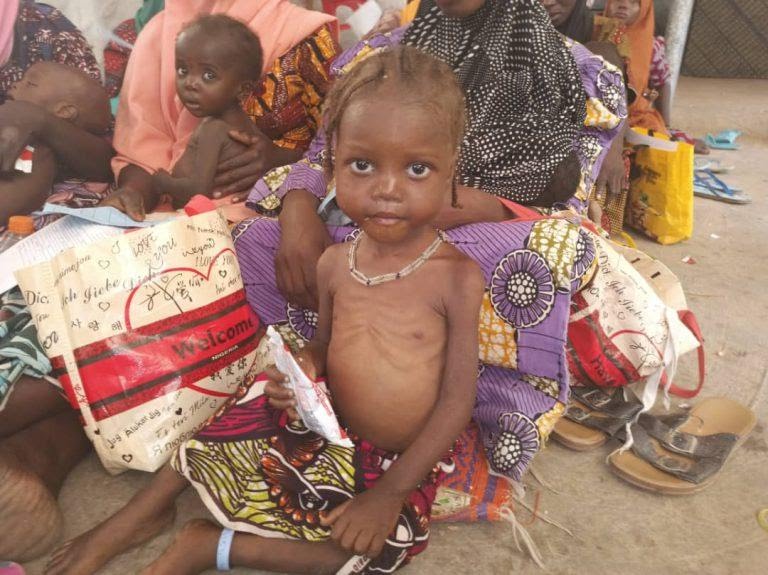Malnutrition crisis: MSF admits over 5,000 children monthly in Katsina

The malnutrition crisis in Katsina State has reached its peak, with Médecins Sans Frontières (MSF) recording a staggering surge in admissions. Daily admissions to MSF facilities in Katsina now exceed 400 cases per day, leading to monthly estimates of over 5,000.
Mallam Hassan Issa, the Project Coordinator of MSF Katsina, disclosed this alarming situation to Vanguard. He explained that previous peak periods witnessed days when the facility admitted up to 400 malnourished children, with 10 to 15 percent of them in critical condition.
Highlighting the gravity of the crisis, Malam Isah stated, “During non-peak seasons, the facility admits approximately 100 cases daily, translating to around 600 to 700 admissions weekly. In essence, our facilities care for an average of about 2,500 malnourished children during off-peak months and about 5,000 in July, which marks the beginning of the peak season.
“But between August and September, which is at the centre of the malnutrition peak season, we are poised to witness the admission of over 10,000 children monthly, considering the 400 now admitted daily.”
Malam Issa explained that approximately 20 percent of complicated child malnutrition cases treated within Katsina MSF Facilities originate from Batsari and Batagarawa Local Government Areas, which are plagued by banditry and suspected terrorism.
Elaborating on this concerning trend, Issa said, “Batsari is particularly significant due to our absence in that Local Government Area. Since MSF doesn’t operate there, the most critical cases often emerge from Batsari. Following Batsari, we encounter a surge of critical conditions from Batagarawa Local Government Area.”
Other LGAs with high complicated cases of children’s malnutrition as disclosed by Issa includes Jibia and Mashi. However, he said MSF’s massive activities in Mashi is gradually changing the narratives in the area.
Mallam Issa emphasized that MSF has been operational in Katsina State since 2021, with a presence in three Local Government Areas (LGAs) and services provided through 10 health facilities, including eight outpatient departments and two stabilisation centres, with a primary focus on treating malnourished children under five years of age.
According to Issa, between 2021 and June 2023, MSF treated over 140,000 children at the Katsina MSF facilities. “Last year alone, we treated more than 100,000 kids in Katsina State across the LGAs they came from,” Hassan revealed. “This year, from January to the end of June, almost 40,000 kids have received treatment through ambulatory outreach, with nearly 6,000 complicated cases in six months,” he stated.
Concerning the surge in demand, at the heart of the peak period; between August and September, Issa highlighted MSF’s measures taken to manage the situation. “To manage the impending surge in severe cases, we have increased the bed capacity at our stabilisation centre from 120 to 300 and we remain vigilant, ready to escalate the bed capacity further to 420 to face the expected increase of admission.”
On the way forward, Ms. Harriet Ayikoru, the MSF Medical Team Leader for Katsina, who also spoke with Vanguard, stressed that MSF cannot tackle this crisis alone. She noted, “In Katsina, despite MSF’s focus on three specific local government areas, patients comes from other LGAs of the state to its facilities. Meaning access for the caregivers is very difficult.” Harriet continues, “Coming from Dutse to Katsina is very difficult, The care should have been taken closer to them but we cannot do it all. So, we are advocating for the other actors to come in to increase the coverage.”
Ms. Ayikoru shed light on MSF’s efforts to manage the crisis. “We have gone into active community engagement to create awareness.” The goal she said “is to sensitize the community about the management of the cases, such that the children are brought for care before they go into severe condition.
“We are also involving some of the mother’s themselves. Once the mothers are admitted here in our stabilisation centre, we start training them on how to identify children who are malnourished in their neighbourhoods. Like, on weekly basis, we train them to even do the measurement’s of the mid upper arm circumference and they are doing it very well and the results are very acceptable. This helps us to have the children identified early before they develop complications.” Harriet expressed.”
Meanwhile, Katsina State Governor, Malam Dikko Umaru Radda, in a bid to address the multifaceted challenges in the state health sector, has pledged to establish 361 fully functional healthcare facilities across the state within his four-year tenure. His plans also includes acquiring mobile ambulances and tricycles to facilitate transportation, ensuring essential first aid during emergencies, particularly in rural areas. These facilities, he said will operate around the clock, providing critical support for childbirth and maternal care, acting as lifelines for expectant mothers and infants.
While Katsina State grapples with this crisis, it is important to note that other state in northwest Nigeria, including Zamfara, Sokoto, and Kebbi, also have their fair share of the malnutrition crisis.
Culled from Vanguard

